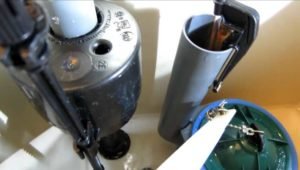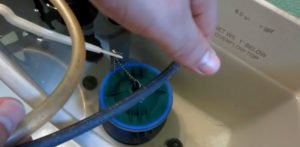Last Updated on December 28, 2024
A toilet is one of the most vital rooms in a house. It has to be kept clean to maintain high levels of hygiene all the time. But like all household fixtures, the toilet parts also wear out, and it develops some issues. One of the common flushing toilet parts that wear out after some time is the fill valve, which ends up causing the toilet to whistle or hiss.
Toilet whistles are usual in aging toilets, but they can be a nuisance. So, if you notice such a sound in your toilet, the noble thing to do is to find out what’s causing the whistle and repair the toilet. If you don’t fix the toilet in good time, you will pay a hefty water bill. Using Toto Drake HDCP or Saniflo Sanibest Macerating Upflush toilet would be an ideal option to get rid of the toilet whistling problem as both have a 3-inches wide fill valve.
Besides, if the toilet fills valve issues persist, you may end up with both a hefty bill and costly repairs in the long run. In this post, we’re going to educate you on where to look and what to do when you hear a whistling sound emerge from your toilet, especially after flushing it.
Possible Causes and Solutions:
| Possible Causes | Solutions |
|---|---|
| Worn out flapper or ballcock | Replace the flapper or the ballcock (also known as the fill valve) to ensure a proper seal. |
| Water pressure issues | Adjust the shut-off valve to lower the pressure, or install a pressure-reducing valve. |
| Faulty fill valve | Clean or replace the fill valve. Sometimes debris can cause the fill valve to make noise. |
| Mineral buildup in the tank | Clean the tank and its components with a suitable descaling solution. |
| Clogged vent pipe | Clear any obstructions from the vent pipe. This may require professional assistance. |
| Misaligned or loose parts | Tighten any loose parts or realign components so they function smoothly. |
| Damaged supply line | Replace the supply line if it is kinked, damaged, or not compatible with your toilet. |
How does a toilet fill valve work?

Before we get to the main cause of the problem, it’s crucial to understand how the toilet flushing system works. The toilet fill valve is normally located on the left side of the toilet tank, with a tailpiece that extends into the bottom of the tank. The extension to the bottom connects to the supply tube that runs to a fixture shutoff valve.
The fill valve works by regulating the amount of water that enters the tank after flushing the toilet. That’s why the whistling sound is normally heard after flushing your toilet. When you flush the toilet, the ball located at the end of a metal armature drops, making the aperture on the other end of the armature open. And when the water rises to fill the tank, the aperture closely slowly stops the water from entering the tank.
What causes a toilet to whistle?

Now the most common question arises, “Why is my toilet whistling?” You know how a toilet fills valve works, you can understand why the toilet whistles when the fill valve parts wear out or get damaged. The main reason the toilet whistles is a damaged fill valve gasket or a worn-out fill valve.
Related article: Know The Exact Reason for Your Toilet Brown Water
When the gasket or fill valve parts get damaged or worn out, they may vibrate. This vibration transfers to the armature and ball; hence, causing the high-pitched sound, whistling, or hissing. The vibration can only stop if the aperture closes completely.
If you have a whistling toilet, you can fix it if the issue is minor. But if it reaches a screeching level, you have no option but to replace the entire fill valve as it’s only a matter of time before the whole valve fails.
How to inspect the toilet’s fill valve

To determine whether the fill valve is causing the whistling noise or not, you have to inspect it. Start by checking the water supply valve. Locate the knob behind the toilet ad make sure it’s completely open. If not, turn it counterclockwise to open it fully. You will pick up a whistling sound as the toilet tank fills up.
Next, check the toilet fill valve if your toilet flushes slowly. Inspect the metal ballcock valve if your toilet has one. Flush the toilet and listen to the whistling sound. If you hear the sound coming from the fill valve, look for any buildup of mineral deposits that may be affecting the water flow. Get rid of any deposits using a damp rag. Flush and see if the problem is gone or persists. Move on to the next step if the problem is not solved.
How to replace the toilet’s fill valve?

After cleaning the fill valve and the whistling persists, you may replace the fill valve. For those with an old metal ballcock valve, you can replace the gasket and stop the whistling. Nonetheless, it’s best to acquire a new fill valve and replace it with an old or damaged fill valve.
Note that new valves are cheap to acquire. Besides, most of them are made from plastic and are less likely to make whistling noises like their metal counterpart. On top of that, newer fill valves are more efficient than older ones, enabling users to save more water and reduce their water bills.
Related article: Easy ways to fix a toilet leaking problem from the tank
If you’ve decided to purchase a new fill valve, here is the procedure to follow to install your new valve properly. Note that you need the right tools, or you may have to hire a professional plumber to assist you.
- Switch off the water supply valve at the back of the toilet
- Flush the toilet and suck up any remaining water using a dry cloth
- Unplug the old supply line from the toilet tank using a wrench
- Unscrew the valve nut holding the fill valve in place
- Remove the fill valve
- Put the new fill valve in position and tighten the lock nut onto the threaded section of the valve
- Reconnect the water supply valve at the back of the toilet tank
- Turn on the water supply and see if there’s any leak
- Adjust the float so that it sits in the correct position
- Allow the tank to fill out and flush the toilet to see if the issue has been rectified.
How to get rid of calcium buildup in the water line?
Calcium buildup is one of the main reasons behind toilet clogs and leaks. If you notice any white elements on your pipe or joints, it is most likely due to a calcium deposit. It usually creates a blockage in the pipe and interrupts the water flow. To clear the calcium buildup, you can follow these steps:
- Pour hot water into the pipe to soften the hard buildup.
- Then pour normal water at high pressure to drain down the calcium deposit through the drainage pipe.
- You can use a water softener or toilet cleaner.
Bottom line
If a whistling sound has been bothering your sleep, you no longer have to tense. It’s easy; inspect your fill valve and ensure that it’s not damaged or worn out. Furthermore, it would be best if you attempted to adjust the fill valve part before replacing it.
Overall, it’s a good idea to replace the fill valve or avoid using low-flow toilets so that the problem does not reoccur. Failure to repair or replace your fill valve can lead to a hefty water bill, which is not a good thing at all. What’s more, you can change the fill valve or acquire the services of a professional plumber at a fee.
FAQs
1. Why does my toilet make a whistling noise when I flush?
The whistling sound often occurs due to a malfunctioning fill valve or a partially blocked water supply line. As water flows through these components, it can create vibrations, leading to a whistling noise.
2. Can a high water pressure cause my toilet to whistle?
Yes, excessively high water pressure can strain the toilet’s fill valve and create a whistling or hissing sound. Installing a pressure-reducing valve can help resolve this issue.
3. How do I fix a toilet that whistles after flushing?
To fix a whistling toilet, inspect the fill valve for damage or debris, clean or replace it if necessary, and ensure the water pressure is at an optimal level. Tighten any loose connections in the plumbing system as well.
4. Is a whistling toilet a sign of a bigger plumbing problem?
A whistling toilet is usually not a major issue but could indicate wear and tear in the fill valve or excessive water pressure. Ignoring it for too long may lead to higher water bills or valve failure.
5. Should I call a plumber to fix a whistling toilet?
If you’re unable to diagnose or resolve the issue on your own, it’s a good idea to call a professional plumber. They can quickly identify the root cause and prevent potential damage to your plumbing system.
Hi, I am Jose S. Franz. Currently, I am working as a professional plumber, and our team offers various plumbing services at an affordable price. After my college education, I completed a vocational certification course in plumbing systems and worked with several construction companies. Since then, I have fixed lots of different toilet models, from older to the latest versions. So I have more than 22 years of experience installing plumbing systems and toilets in both residential and commercial buildings.



